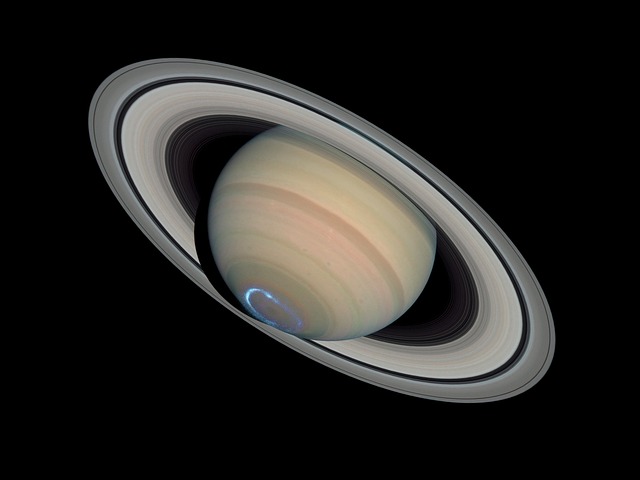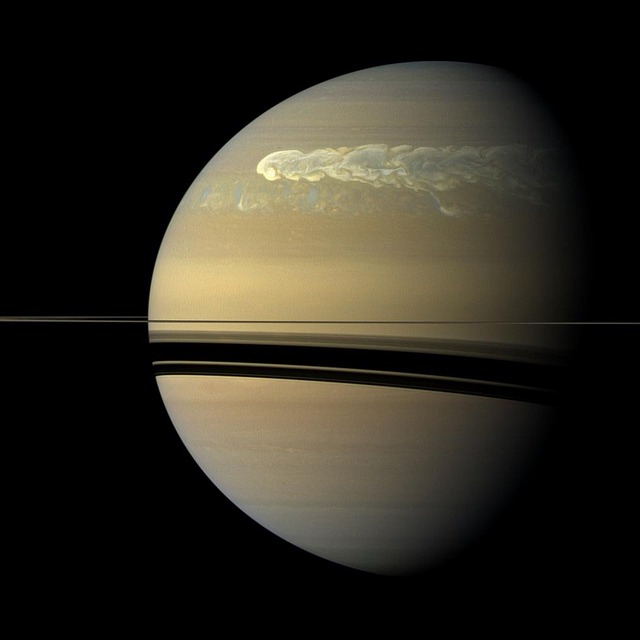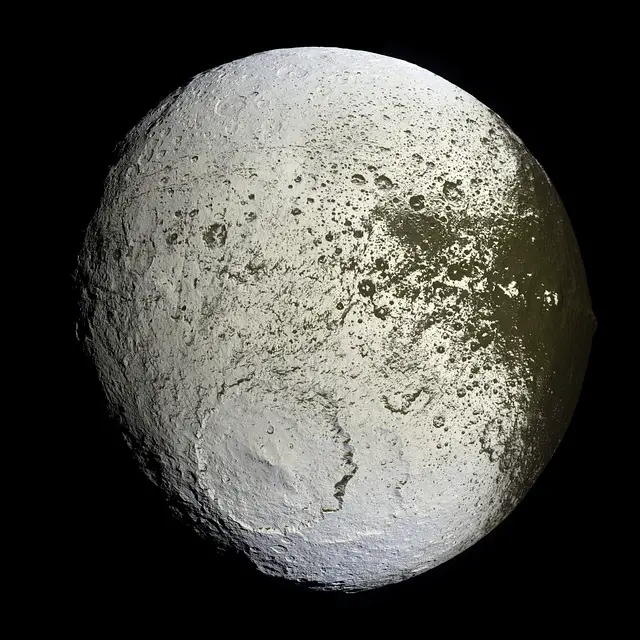Saturn is the sixth planet from the Sun and the second largest in the Solar System, just behind Jupiter. It is located between the two gas giants, Jupiter and Uranus, and is often referred to as the “jewel of the Solar System”.
Saturn is a fascinating planet that has been studied for centuries, and it still holds many secrets that are waiting to be uncovered.
Introduction
Saturn is best known for its impressive system of rings that make it stand out among the other planets in our Solar System. The rings encircle the entire planet, and they are composed of billions of pieces of icy rock, dust, and other particles. Saturn is also home to a number of moons, of which 62 have been identified so far, including some of the most well-known such as Titan and Enceladus.
Saturn has a diameter of approximately 120,660 km, which makes it the sixth-largest planet in the Solar System. It is composed mainly of hydrogen and helium, and it is the least dense planet in the Solar System, with a density lower than water. Saturn rotates much faster than other planets, with a day that is the same length as its year.
The temperature of Saturn’s atmosphere is around -139°C to -184°C, and its atmosphere is composed of hydrogen and helium. Saturn has the strongest winds in the Solar System, with speeds up to 1,800 km/h.

Saturn is named after the Roman god of agriculture, and it is associated with the Greek god Cronus. It is believed that Saturn is the most ancient of all the gods, and he was revered by many cultures throughout history.
Saturn has been explored by several robotic spacecraft such as Cassini–Huygens and Voyager, which have provided us with detailed data on the planet’s environment and helped us to explore the depths of Saturn’s atmosphere. This exploration has further increased our understanding of Saturn and continues to uncover many of its hidden secrets.
Saturn is a fascinating planet that has much more to offer than what is currently known. From its impressive rings to its many moons and its turbulent storms, Saturn is a planet full of surprises and an interesting source of knowledge.
In this article, we will explore some of the most interesting facts about the planet Saturn.
Physical Characteristics
Saturn is the sixth planet from the Sun and the second-largest planet in the Solar System, with a diameter of around 120,660 km. Saturn is located between Jupiter and Uranus and is composed mostly of hydrogen and helium.
It is easily visible to the naked eye from Earth, and it is the least dense of all the planets in our Solar System.
Saturn has a total of 62 moons and nine major rings that are made up of small particles of ice, rocks, and dust. The rings are believed to have been formed when a comet or an asteroid was pulled apart by the planet’s gravity.
The rings are divided into seven main groups, and the most prominent is the A ring.
The temperatures in the atmosphere of Saturn range from -139°C to -184°C, making it one of the coldest planets in our Solar System. The atmosphere of Saturn is composed of hydrogen and helium, and it has the most powerful winds in the Solar System, with speeds up to 1,800 km/h.
Saturn’s rotation is extremely fast compared to other planets. It completes one rotation in just 10.7 hours, making it the fastest-spinning planet in the Solar System. The day on Saturn is the same length as its year, which lasts for 29.5 Earth years.
Saturn’s moons are a diverse and interesting group of objects. Some of the most notable moons include Titan, Enceladus, Rhea, Dione, Hyperion, and Mimas. Each of these moons has its own unique features and characteristics. Titan is the largest moon of Saturn and is the only moon in our Solar System with a thick atmosphere.
Enceladus is an icy moon that is covered in geysers that spew water vapor and ice particles. Rhea is the second-largest moon and is covered in bright wispy lines that are thought to be created by particles that are ejected from Enceladus. Dione is another icy moon and is covered in craters.
Hyperion is a small moon that has an irregular shape and is covered in dark material. Last but not least is Mimas, which is a small moon that has a large crater that is thought to have been caused by an asteroid impact.
Interesting Facts
Saturn is the least dense planet in the Solar System, with a density lower than water. This is due to its composition of mostly hydrogen and helium, and its large size. Even though Saturn is the sixth planet from the Sun, it is the second-largest in the Solar System, with a diameter of around 120,660 km. This makes it considerably larger than Earth.
Saturn is the only planet that is visible to the naked eye from Earth. This is because of its large size and bright rings. Although other planets may be seen with the aid of a telescope, Saturn can be seen with the unaided eye.
Saturn is also unique in that it rotates much faster than other planets in the Solar System. Its day is only 10.2 hours long, while its year is 29 Earth years. This means that the planet’s day is the same length as its year.
Despite being the sixth planet from the Sun, Saturn is also known for its impressive number of moons; it has a total of 62 moons, including nine major moons. These moons are the source of many interesting phenomena, such as the presence of the planet’s famous rings. The rings are composed of small particles of ice and rock and scientists believe that they were created by the breaking up of one of Saturn’s larger moons.

Saturn is named after the Roman god of agriculture and is associated with the Greek god Cronus. This is fitting, as the planet is known for its beauty and distinctive rings. The presence of the rings has made the planet a popular topic of study and exploration.
Saturn has been explored by several robotic spacecraft, such as Cassini–Huygens and the Voyager missions. This exploration has provided us with detailed data on the planet’s environment and scientists have been able to explore the depths of Saturn’s atmosphere.
The temperature of Saturn’s atmosphere is around -139°C to -184°C and the atmosphere is composed mostly of hydrogen and helium. Saturn has the strongest winds in the Solar System with speeds up to 1,800 km/h.
Saturn is an interesting and mysterious planet full of surprises. It has been studied for centuries and still has many secrets waiting to be uncovered. As a result of its size and composition, Saturn has some of the most unique features in the Solar System.
Its rings, moons, and atmosphere are all fascinating and make Saturn a planet worth exploring.
Mythology
Saturn has been known since ancient times, with its name derived from the Roman god of agriculture. The planet is also associated with the Greek god Cronus, the father of the Olympians. This connection has been made due to Cronus’ brother, Jupiter, being the namesake of the fifth planet from the Sun.
Saturn has been connected to many religious beliefs, including the Hindu superstition that Saturn can cause bad luck and destruction.
The day and year on Saturn are the same lengths due to its slow rotation. One day on Saturn is equivalent to 10 hours, 39 minutes, and 24 seconds on Earth. Its year is equivalent to 29 1/2 years on Earth. This means that Saturn completes its orbit around the Sun in the same amount of time it takes for the planet to rotate once about its axis.
Saturn was also associated with one of the oldest and most popular gods of all, Chronos, the grandfather of all the gods and titans. In Greek mythology, Chronos is depicted as devouring his own children, a symbol of his own mortality. This association has been connected to Saturn because of its slow rotation, which can be seen as the god of time-consuming its own offspring.
The planet Saturn has also been linked to the ancient Babylonians and the Sumerian god Ninurta. In Babylonian mythology, Ninurta was a storm god who used his magical bow to shoot down the celestial serpent, Mummu, which symbolized the planet Saturn. Ninurta is also credited with creating the constellation known as the Corona Borealis.
Saturn is also associated with the Greek god Helios, the god of the Sun. The planet was believed to be the brother of Helios, as they shared the same father, Hyperion. Helios was thought to have been born in the land of the Hyperboreans, a group of mythical people who lived far to the north of Greece.
The ancient Greeks have an interesting story about Saturn, in which the planet was thought to be the source of all the gods’ power. According to the myth, Saturn was the first god that emerged from the primordial chaos and was entrusted with the task of bringing order to the universe.
It is believed that Saturn was the first god to bring the gods together to form the Olympian Council.
Saturn has long been a symbol of time and mortality, and its appearance in the night sky has been seen as a reminder of the fragility of life.
The planet is associated with the passage of time and the inevitability of death. For this reason, Saturn has been a popular symbol in art, literature, and religion for centuries.
Weather and Climate
Saturn is unique in many ways, and its weather and climate are no exception. The temperature of Saturn’s atmosphere is around -139°C to -184°C. This is far colder than any other planet in the Solar System. In comparison, the coldest temperature on Earth is -88°C. It’s also incredibly dry, with only traces of water vapor.
The atmosphere of Saturn is composed of mainly hydrogen and helium, with traces of other elements such as ammonia, methane, carbon dioxide, and acetylene. It is the second most abundant gas in Saturn’s atmosphere, making up 98.3%. It is also the lightest gas, which means it produces the weakest gravitational pull.
Saturn is home to the strongest winds in the Solar System. Wind speeds can reach up to 1,800km/h. This is more than twice the speed of Earth’s most powerful hurricanes. The winds are thought to be generated by the planet’s internal heat. The rapid rotation of the planet also plays a role in creating these strong winds.
The clouds of Saturn are composed of ammonia, ammonium hydrosulfide, and water ice. These clouds form a thick, colorful layer that gives the planet its distinct look.

iapetus
The clouds can reach heights of up to 40 km above the surface of Saturn. The most prominent feature of the clouds is the Great White Spot, which is a giant storm that appears in the planet’s northern hemisphere every 30 years.
Saturn’s magnetic field is also strong. Scientists believe the field is generated by an internal dynamo effect that occurs when the planet rotates. The magnetic field is almost 20 times more powerful than Earth’s magnetic field and is thought to be responsible for the planet’s auroras.
Saturn’s environment is also unique in the Solar System. Its atmosphere is filled with complex molecules that make it difficult for spacecraft to penetrate its outer layers. Saturn’s environment is also much more dynamic than those of other planets, making it a challenging target for exploration.
Saturn has been explored by several robotic spacecraft like Cassini–Huygens and Voyager. These spacecraft have provided us with detailed data on the planet’s environment. Scientists have been able to explore the depths of Saturn’s atmosphere, allowing us to better understand the planet and its environment.
Exploration
Exploring Saturn has been a remarkable journey for scientists. This gas giant has been studied for centuries and has still managed to keep its secrets hidden. Saturn has been explored by several robotic spacecraft, namely Cassini–Huygens and Voyager.
The Cassini–Huygens mission was launched in 1997 with the intent to study the planet Saturn and its moons. This spacecraft was the first to get an up-close view of the planet and its rings. The mission also included the Huygens probe, which was the first human-made object to land on the moon of Saturn.
The probe was able to send back data on the atmosphere and surface of the moon Titan. The Cassini–Huygens mission has provided us with detailed information on the environment of Saturn, including its moons and rings.
The Voyager mission, which launched in 1977, was a mission to explore the outer planets of our solar system. The Voyager 1 and 2 spacecraft were able to fly by Saturn in the 1980s and take pictures and data that allowed scientists to understand more about the planet and its environment. The spacecraft was able to study the atmosphere, rings, moons, and magnetic field of Saturn.
The spacecraft have allowed scientists to explore the depths of Saturn’s atmosphere. The atmosphere can be broken down into several layers, including the troposphere, stratosphere, mesosphere, and thermosphere. Each layer has distinct characteristics such as temperature, pressure, and composition. The data collected by the spacecraft has allowed scientists to better understand the environment of Saturn.
The spacecraft have also enabled us to explore the moons of Saturn. Scientists have been able to study the composition, atmosphere, and magnetic field of these moons. This has allowed us to gain a better understanding of their formation and evolution.
The exploration of Saturn has provided us with an abundance of new data and knowledge about this planet. We have been able to uncover details about its atmosphere, rings, and moons. The spacecraft have also enabled us to gain a better understanding of the environment of Saturn and the formation of its moons.
This exploration has been a remarkable journey and has provided us with a much better understanding of this fascinating planet.
Conclusion
Saturn is an intriguing and mysterious planet with a plethora of surprises. Its size, rings, and moons are some of the most recognizable features in our Solar System, and thousands of years of observation and study have helped us to better understand this mysterious celestial body.
Despite the vast amount of information we have collected about Saturn, it still has many secrets yet to be discovered. The exploration of Saturn by spacecraft such as Cassini–Huygens and Voyager have provided us with detailed data on the planet’s environment, allowing us to gain insight into the depths of its atmosphere. Scientists are still studying Saturn and have made many exciting discoveries over the past few decades.
One of the more fascinating facts about this sixth planet from the sun is that it rotates much faster than other planets. It is also the least dense planet with a density lower than water. Saturn’s diameter is around 120,660 km and it has a total of 62 moons and nine major rings. This outer gas giant is composed mostly of hydrogen and helium, and its day is the same length as its year.
The atmosphere of Saturn is composed of hydrogen and helium, and its temperature can range from -139°C to -184°C. It also has the strongest winds in the Solar System with speeds reaching up to 1,800km/h. This combination of extreme temperatures and powerful winds makes it a hostile environment.
Saturn is an incredible planet full of wonders and mysteries. Even after centuries of studying and exploration, there are still many secrets waiting to be uncovered. With the help of advancing technology and research, we are able to gain a better understanding of this celestial body and the solar system it resides in.
Saturn is a fascinating planet that has much more to offer than what is known today.
Links
We have facts about Staurn right here for you – Various facts about the planet Saturn
